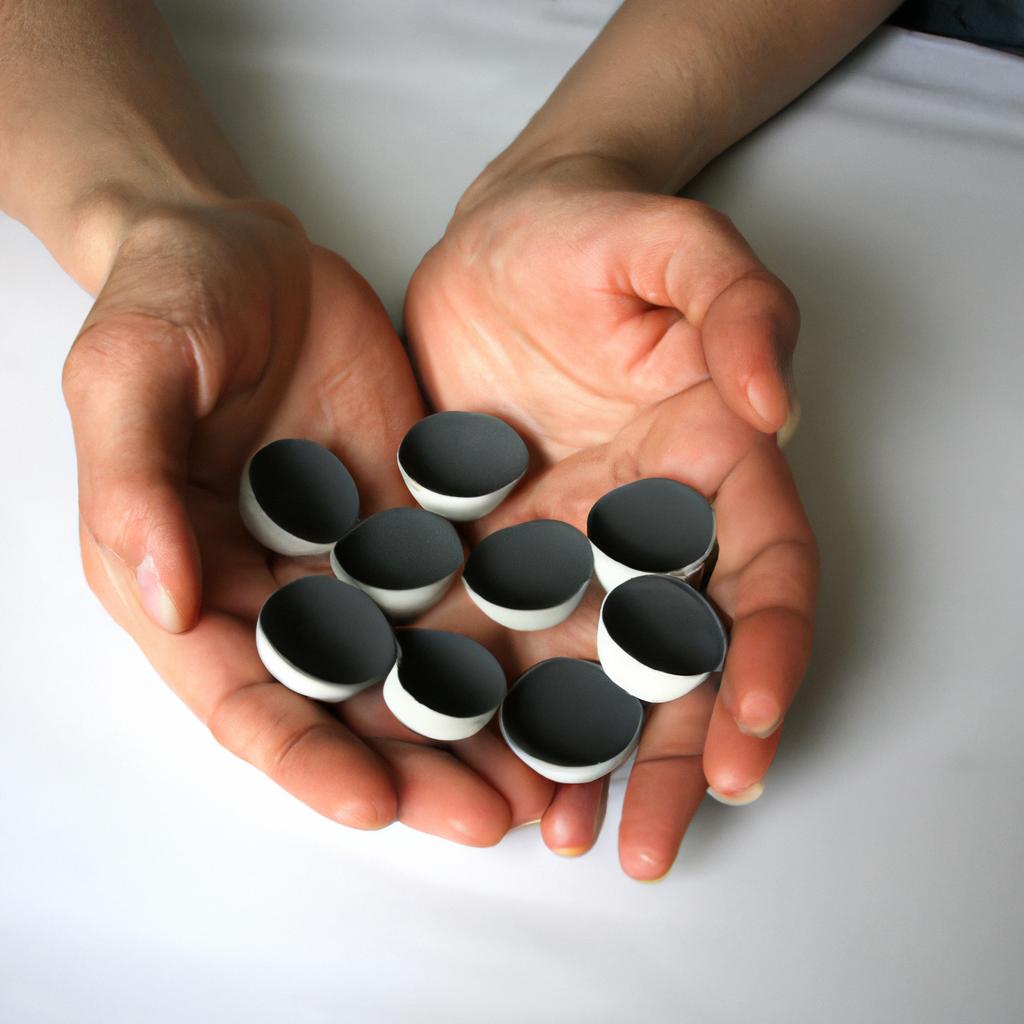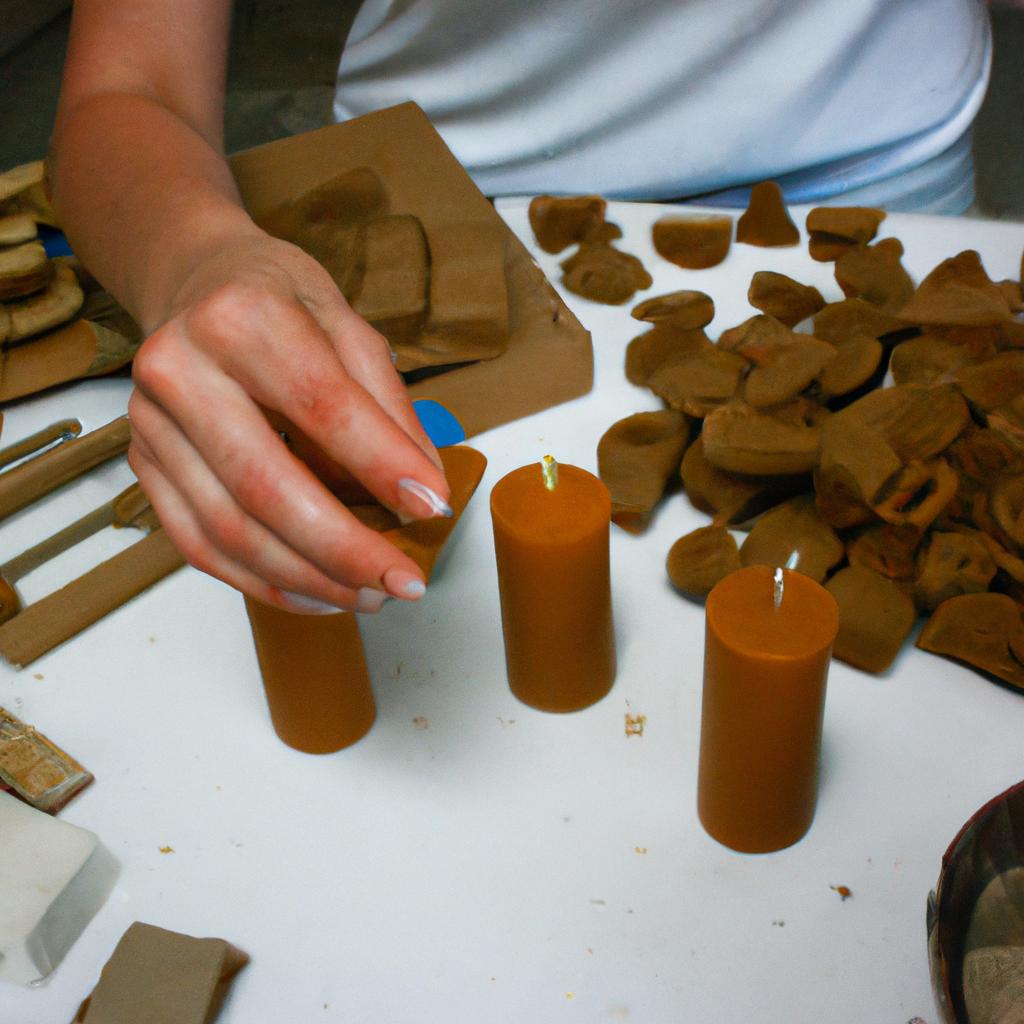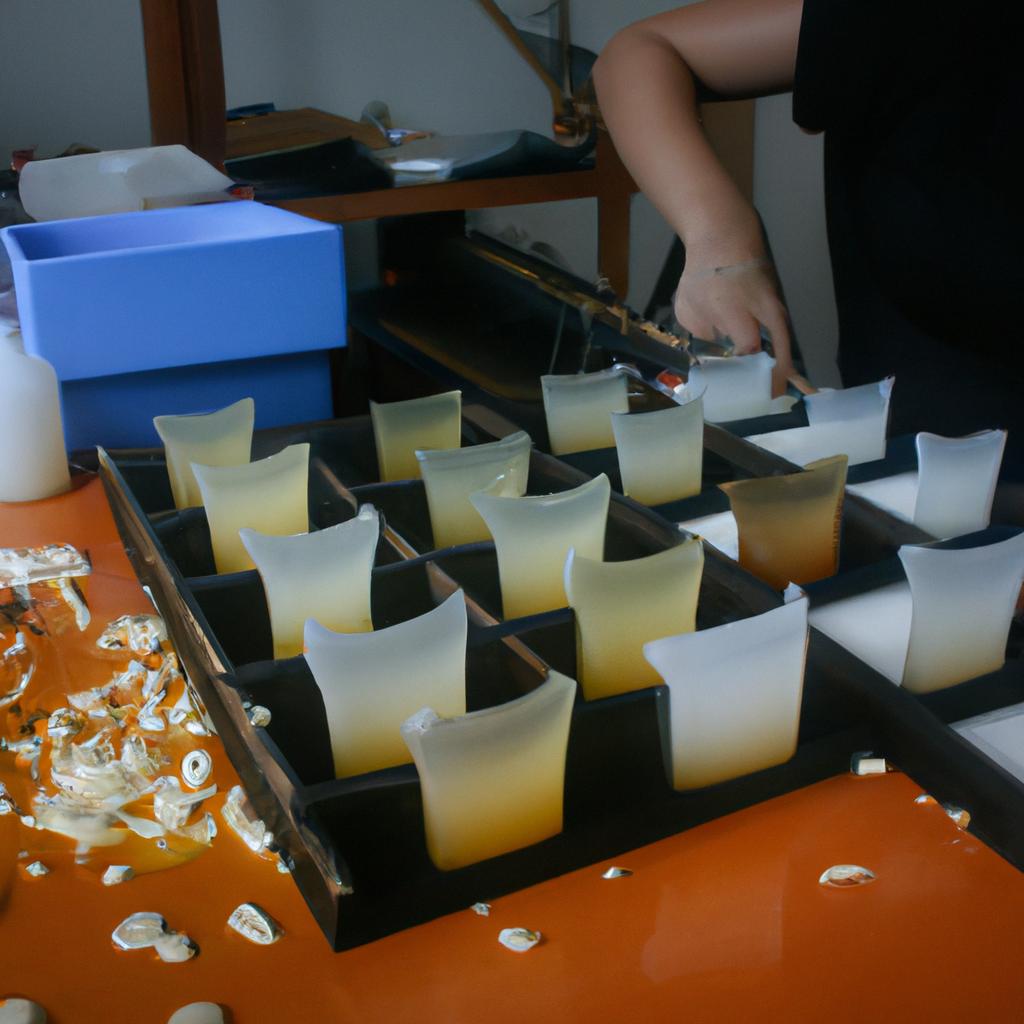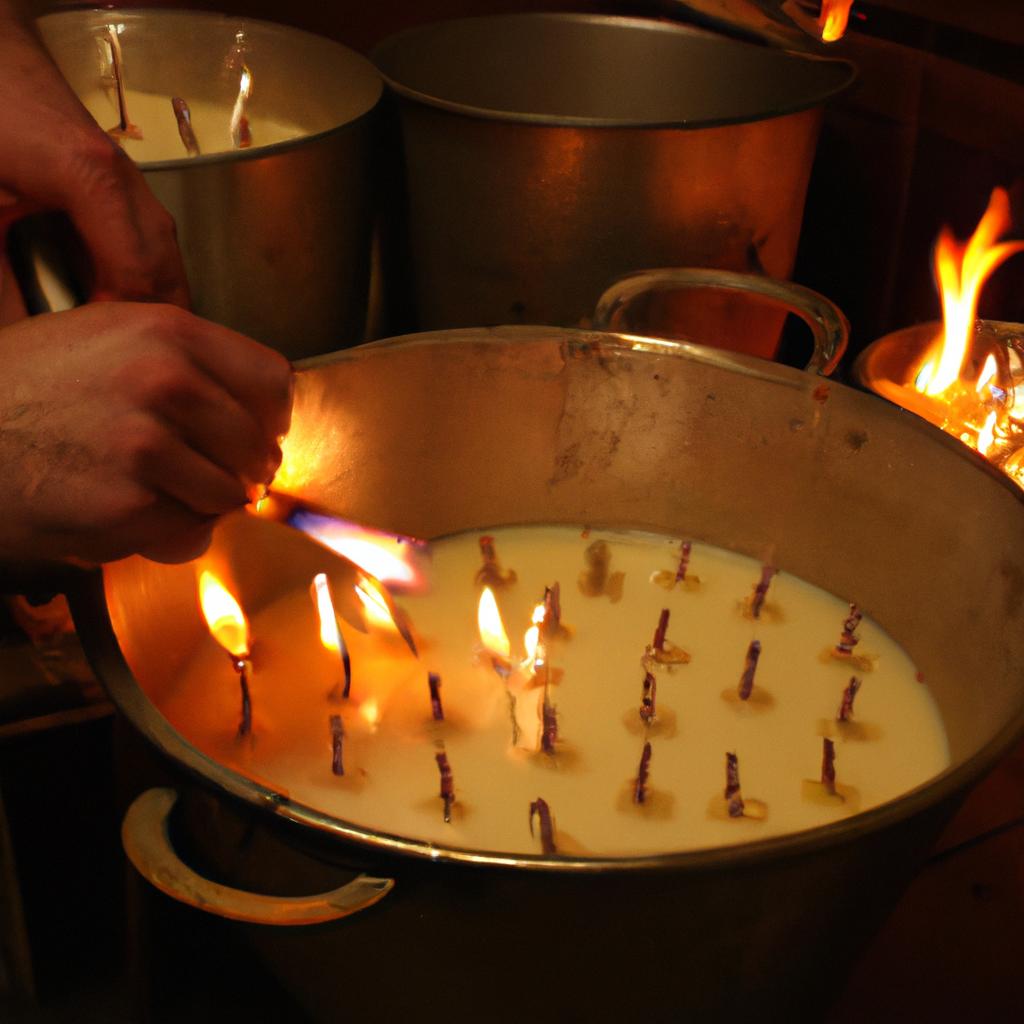Votive Molds: Candle Making’s Candle Molds
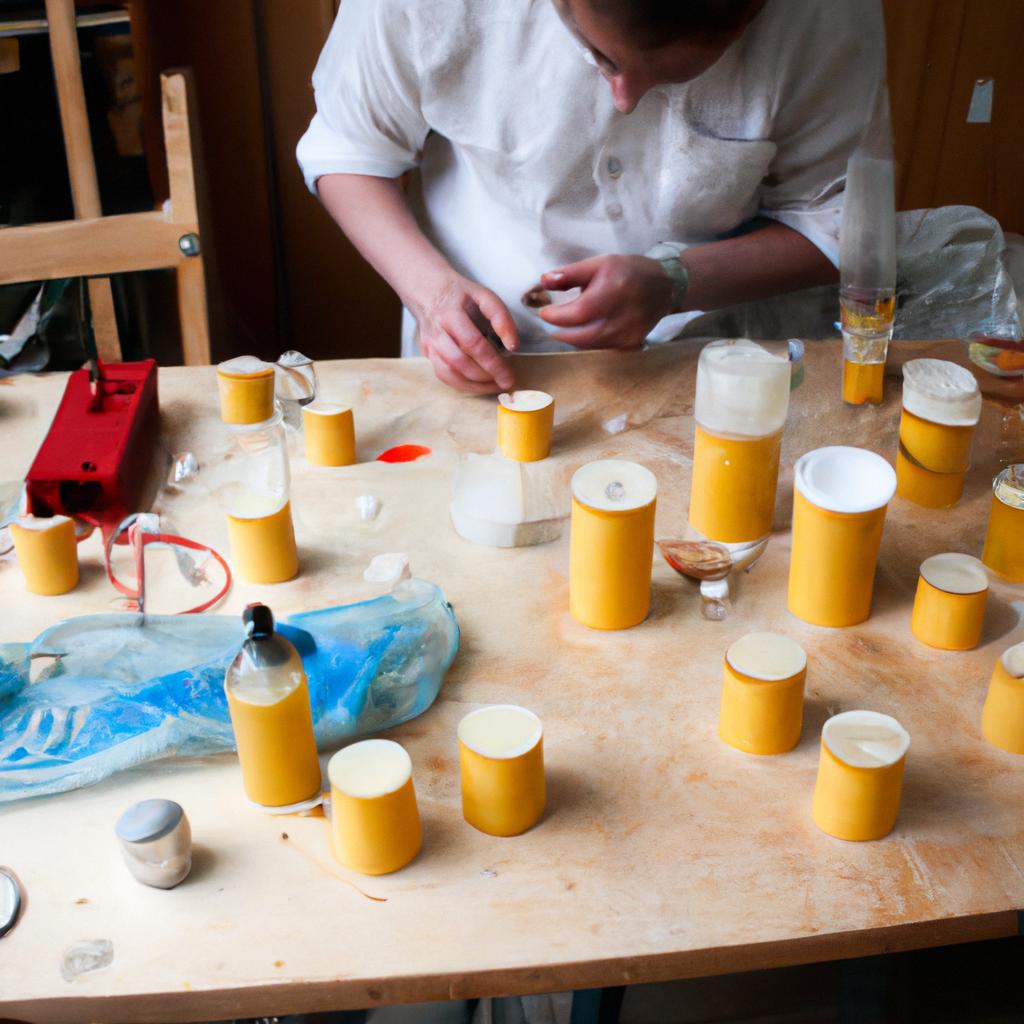
Candle making has been a significant craft throughout history, with the use of molds playing a crucial role in shaping and defining candles’ final form. Among the various types of candle molds used, votive molds hold a unique place due to their versatility and practicality. For instance, imagine a scenario where an experienced candle maker desires to create a set of uniform and aesthetically pleasing votive candles for an upcoming wedding ceremony. In such cases, votive molds come to the rescue by providing an efficient method for producing multiple identical candles simultaneously.
Votive molds are specifically designed to produce small cylindrical or slightly tapered candles known as “votives.” These compact-sized candles have gained popularity not only for their functional purposes but also for their aesthetic appeal when placed in decorative holders during religious ceremonies, rituals, or even as home decor items. The advent of industrialization revolutionized the production process, allowing manufacturers to mass-produce votive molds made from materials like metal, silicone, or plastic. This development not only increased accessibility but also facilitated customization options through intricate designs and patterns engraved on the mold’s inner surface.
In this article, we will delve into the world of votive molds: exploring their historical significance, examining different manufacturing techniques employed over time, and discussing some tips and tricks for using votive molds effectively. Whether you’re a seasoned candle maker or a beginner looking to experiment with this craft, understanding the ins and outs of votive molds will undoubtedly enhance your candle making journey. So, let’s dive in!
Different types of votive candle molds
One popular type of candle mold used in the art of candle making is the votive mold. Votive candles are small, cylindrical candles that are typically burned within a container or holder to catch melted wax. These candles have gained popularity due to their versatility and aesthetic appeal. In this section, we will explore different types of votive candle molds, highlighting their unique features and benefits.
To begin with, silicone molds have become increasingly popular among candle makers for their flexibility and durability. Made from food-grade silicone materials, these molds offer excellent heat resistance and can withstand repeated use without losing their shape. The smooth texture of silicone allows for easy release of finished candles, resulting in a clean and professional-looking product.
Another option for creating votive candles is using metal molds. Typically made from aluminum or tin-plated steel, metal molds provide sturdy support during the pouring process and help maintain the desired shape of the candle as it solidifies. They come in various sizes and designs, allowing for customization based on individual preferences.
For those looking for a more traditional approach, there are also plastic votive molds available in the market. Plastic molds are lightweight and affordable, making them ideal for beginners or hobbyists exploring candle making as a creative outlet. However, they may not be as durable as silicone or metal molds and require careful handling to prevent breakage.
When choosing a votive mold, consider factors such as ease of use, durability, cost-effectiveness, and personal preference. To further assist you in making an informed decision, here is a bullet point list summarizing key points about each type:
-
Silicone Molds:
- Flexible and durable
- Easy release of finished candles
- Heat resistant
- Professional finish
-
Metal Molds:
- Sturdy support during pouring
- Maintains shape well
- Customizable options available
- Durable and long-lasting
-
Plastic Molds:
- Lightweight and affordable
- Suitable for beginners or hobbyists
- Requires careful handling
- May not be as durable
In summary, votive candle molds come in various materials, each offering unique advantages. Silicone molds provide flexibility and durability, metal molds offer sturdiness and customization options, while plastic molds are lightweight and budget-friendly.
Now that we have discussed different types of votive candle molds, let us delve into the essential materials required to create these molds efficiently.
Materials needed for making votive molds
Different types of votive candle molds provide various options for candle makers to create unique and beautiful candles. In this section, we will explore some of the different types of votive candle molds available in the market.
To illustrate the versatility of these molds, let’s consider a case study: Sarah is an experienced candle maker who wants to expand her product line by introducing votive candles with intricate designs. She decides to invest in different types of votive molds to achieve this goal.
-
Silicone Molds: These flexible and durable molds are popular among candle makers due to their ease of use and ability to capture fine details. Sarah purchases silicone mold sets featuring floral patterns and geometric shapes, allowing her to experiment with creating visually appealing votives that appeal to a wide range of customers.
-
Aluminum Molds: Known for their heat conductivity, aluminum molds ensure efficient heat distribution during the candle-making process. This results in consistent wax melting and prevents uneven burning in finished candles. Inspired by traditional aesthetics, Sarah acquires aluminum votive molds with classic motifs such as ribbons and filigree patterns, adding an elegant touch to her collection.
-
Plastic Molds: Ideal for beginners or those on a budget, plastic molds offer affordability without compromising quality. They come in various sizes and shapes, including standard cylindrical forms or novelty designs like animals or fruits. Sarah recognizes the value of offering cost-effective options while still delivering aesthetically pleasing products; thus, she incorporates plastic votive molds into her repertoire.
-
Glass Molds: Transparent glass votive molds allow for creative experimentation with layers and embedments within the candles themselves. By pouring different colored waxes or embedding decorative elements like dried flowers or beads between layers, Sarah can produce stunning visual effects that captivate customers’ attention.
Table showcasing different materials used for making votive molds:
| Material | Advantages | Disadvantages |
|---|---|---|
| Silicone | Captures fine details, easy to use | Relatively expensive |
| Aluminum | Efficient heat distribution | Can be costly for high-quality molds |
| Plastic | Affordable and versatile | Less durable compared to other types |
| Glass | Allows for creative layering and embeds | Requires careful handling during use |
By investing in a range of votive candle molds, Sarah can cater to different customer preferences while showcasing her creativity. These diverse mold options enable her to produce an array of visually appealing votives that stand out in the market.
Step-by-step guide to creating votive molds
Creating your own votive molds allows you to customize the shape and size of your candles, adding a personal touch to your candle-making process. Let’s explore how to create these unique candle molds.
Imagine you want to make a set of decorative votive candles shaped like flowers. By using specially designed flower-shaped silicone molds, you can achieve intricate details that will enhance the beauty of your finished candles. These molds provide an easy way to replicate consistent shapes with each pour, ensuring professional-looking results every time.
To successfully create your own votive molds, follow these steps:
-
Choose appropriate materials:
- Silicone or plastic mold material
- Heat-resistant container for melting wax
- Wick holders
- Thermometer for monitoring wax temperature
-
Prepare the mold:
- Ensure the mold is clean and dry before use.
- Apply a release agent if necessary.
-
Pouring the wax:
- Melt the wax in a heat-resistant container following recommended guidelines.
- Monitor and maintain an optimal pouring temperature.
-
Curing and demolding:
- Allow sufficient time for the wax to cool and solidify within the mold.
- Gently remove the cured candle from the mold by flexing or twisting it.
By carefully following these steps, you’ll be able to craft stunning votive candles with various shapes and sizes that are sure to impress.
Now let’s move on to exploring some tips for achieving perfect votive candle shapes as we delve deeper into this exciting world of candle making.
Tips for achieving perfect votive candle shapes:
As you embark on crafting your own unique votive candles, consider incorporating these helpful tips into your process:
| Tips for Perfect Votive Candles |
|---|
| 1. Experiment with various mold materials to discover the best option for your specific candle design. |
| 2. Use high-quality wax and fragrance oils to ensure optimal results in terms of scent throw and burn time. |
| 3. Pay attention to the pouring temperature, as different waxes require varying temperatures for successful molding. |
| 4. Consider adding colorants or other decorative elements such as dried flowers or glitter to enhance the visual appeal of your votive candles. |
These tips will assist you in creating beautifully shaped votive candles that not only illuminate your surroundings but also evoke a sense of comfort and relaxation.
In our next section, we’ll delve into additional techniques and tricks to further refine your skills in achieving perfect votive candle shapes effortlessly.
Tips for achieving perfect votive candle shapes
Having learned the step-by-step process of creating votive molds, let us now delve into some tips that can help you achieve perfect votive candle shapes. To illustrate the effectiveness of these tips, consider a case study where an avid candle maker faced challenges in getting consistent and flawless votive candles.
Tips for achieving perfect votive candle shapes:
-
Use high-quality materials: The quality of the mold material directly affects the final outcome of your votive candles. Opt for durable silicone or metal molds specifically designed for votives to ensure precise shape retention during pouring and cooling processes.
-
Proper wicking: Selecting the appropriate wick size is crucial for obtaining well-formed votive candles. A wick that is too thick may result in uneven burning, while one that is too thin could cause tunneling – leaving wasted wax along the sides. Experiment with different sizes to find the ideal match for your desired burn time and consistency.
-
Correct temperature control: Maintaining optimal pouring temperatures when working with molten wax ensures proper adhesion between layers and reduces surface imperfections in finished candles. Be mindful of both ambient room temperature and wax temperature before pouring each layer, as extreme variations can lead to cracking, frosting, or incomplete filling.
- Emotional bullet point list *
- Achieve a sense of satisfaction by producing visually appealing votive candles.
- Enhance customer trust through consistently excellent craftsmanship.
- Enjoy increased market demand by offering desirable decorative items.
- Feel inspired to explore creative possibilities with perfectly shaped votives.
- Accurate measurements: Precise measurements are vital when determining the right amount of wax needed per mold to avoid underfilling or overflow issues. Keep in mind that different types of wax have varying shrinkage rates upon cooling, so factor this into your calculations accordingly.
| Wax Type | Shrinkage Rate |
|---|---|
| Soy | 5% |
| Beeswax | 10% |
| Paraffin | 8% |
| Palm wax | 6% |
Incorporate these tips into your votive candle-making process to overcome challenges and consistently achieve stunning results. By using high-quality materials, selecting appropriate wicking, controlling temperatures accurately, and measuring meticulously, you can ensure that each votive candle is a work of art.
With the knowledge of creating perfect votive molds firmly in place, let us now explore the various decorative options available for enhancing the aesthetic appeal of your candles.
Decorative options for votive candle molds
In the previous section, we explored various tips for achieving perfect votive candle shapes. Now, let’s delve deeper into some additional techniques that can help you create stunning votive candles using molds.
To illustrate the effectiveness of these techniques, let’s consider a hypothetical case study. Imagine you are a passionate candle maker who wants to create a set of beautifully shaped votive candles as party favors for an upcoming event. By following these tips and techniques, your candles will impress guests with their exquisite designs and flawless finishes.
Enhancing Your Votive Candle Designs
- Experiment with different wax blends: Try blending different types of waxes like soy wax or beeswax with paraffin wax to achieve unique textures and colors in your votive candles.
- Utilize fragrance oils strategically: Incorporate scented oils into your votive candles to enhance their appeal. Consider how specific fragrances complement the theme or purpose of your candles.
- Explore creative additives: Add visual interest by incorporating elements such as dried flowers, herbs, or decorative glitters into your candle mixture before pouring it into the mold.
- Play with colorants: Experiment with various pigments or dyes to achieve vibrant hues in your votives. Remember to follow safety guidelines when working with colorants.
| Wax Blend | Fragrance Oil | Decorative Additives | Colorant |
|---|---|---|---|
| Soy + Beeswax | Lavender | Dried rose petals | Purple |
| Paraffin | Vanilla | Gold glitter | Ivory |
| Beeswax | Citrus blend | Dried orange slices | Orange |
| Soy | Sandalwood | None | Cream |
By exploring these options, you can create votive candles that not only offer a mesmerizing visual experience but also evoke specific emotions or memories in those who receive them.
Now that we have covered the techniques for achieving perfect votive candle shapes and enhancing their designs, let’s move on to the next section where we will discuss common mistakes to avoid when using votive molds. By being aware of these pitfalls, you can ensure your candle-making process goes smoothly and yields exceptional results.
Common mistakes to avoid when using votive molds
Decorative options for votive candle molds offer a wide range of possibilities to enhance the aesthetic appeal of your candles. By selecting the right decorative elements, you can create unique and eye-catching votives that stand out from the crowd. One example is using dried flowers or herbs to embed into the wax, adding both visual interest and a subtle fragrance to your candles.
To further explore the creative potential of votive molds, consider the following four ideas:
-
Embedding objects: Whether it’s small seashells, colorful beads, or even tiny gemstones, embedding objects into your votive candles can create an intriguing effect. As the candle burns down, these embedded items become visible through the translucent wax, captivating viewers with their unexpected presence.
-
Layering different colored waxes: Experimenting with multiple layers of differently colored wax allows you to achieve captivating visual effects in your votives. This technique can be used to create gradient patterns, geometric designs, or even abstract swirls by carefully pouring and cooling each layer.
-
Adding texture: Textured surfaces add depth and complexity to votive candles. You can achieve this by incorporating materials like sand or crushed glass into the mold before pouring in the wax. The resulting textured finish adds tactile interest and catches the light beautifully when illuminated.
-
Customizing with paint or ink: For those looking for more intricate designs on their votives, painting or applying ink directly onto the surface offers endless possibilities. From delicate brush strokes creating floral motifs to bold graphic patterns achieved with stencils, this method enables precise customization limited only by one’s artistic imagination.
In addition to these creative techniques, it’s important to be aware of common mistakes that should be avoided when working with votive molds. Understanding these pitfalls will help ensure successful outcomes while maximizing your creativity and productivity in candle making.

